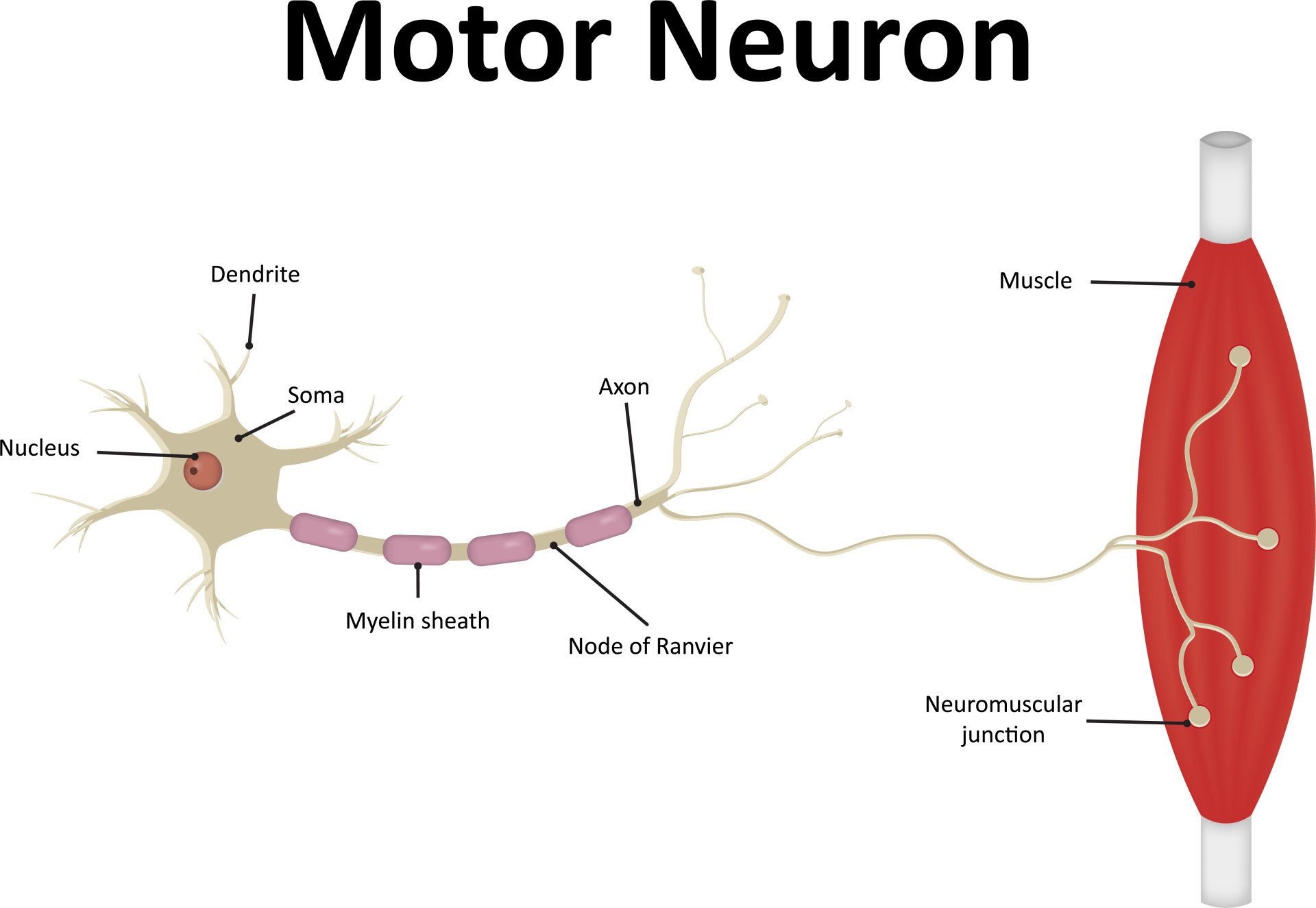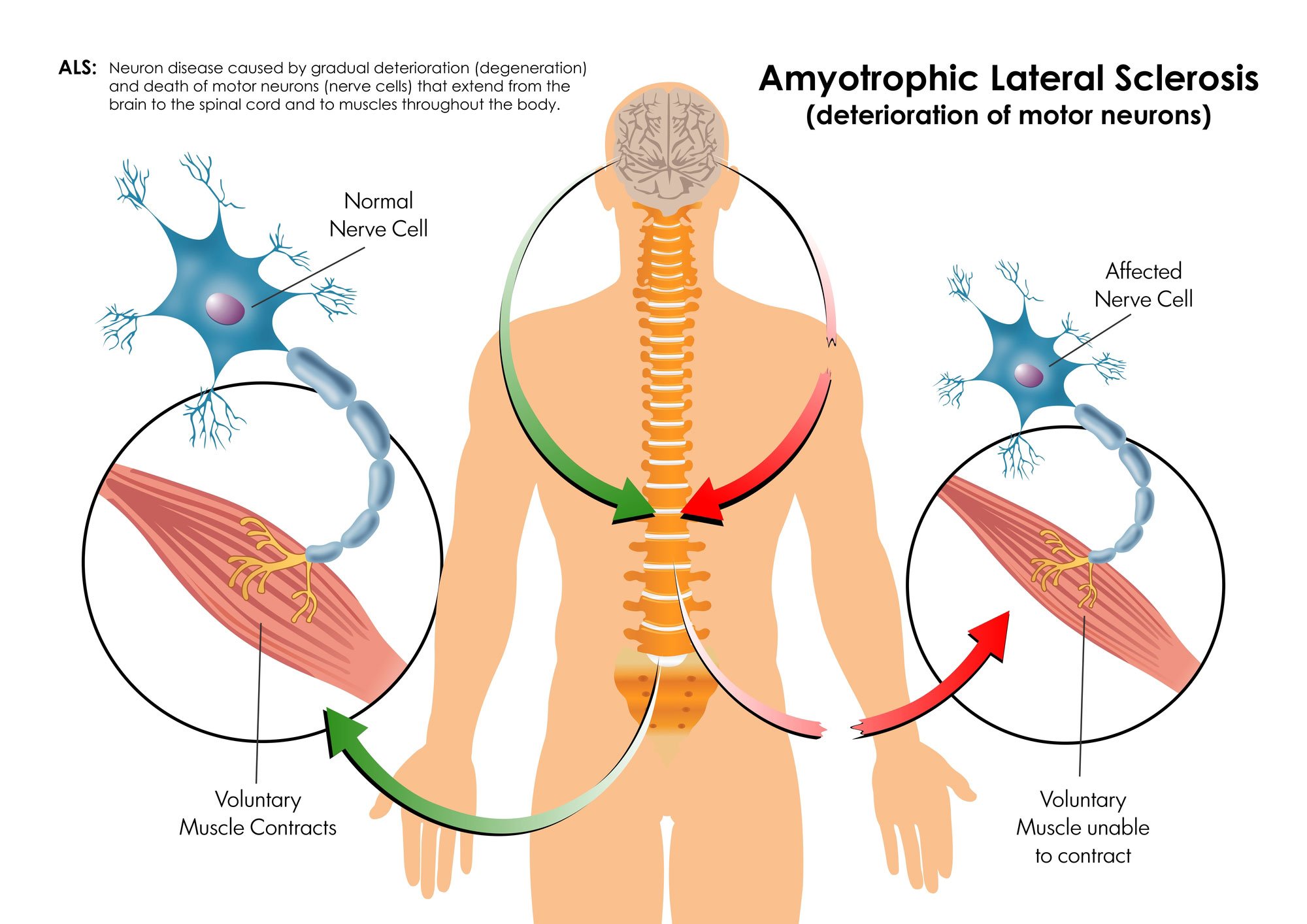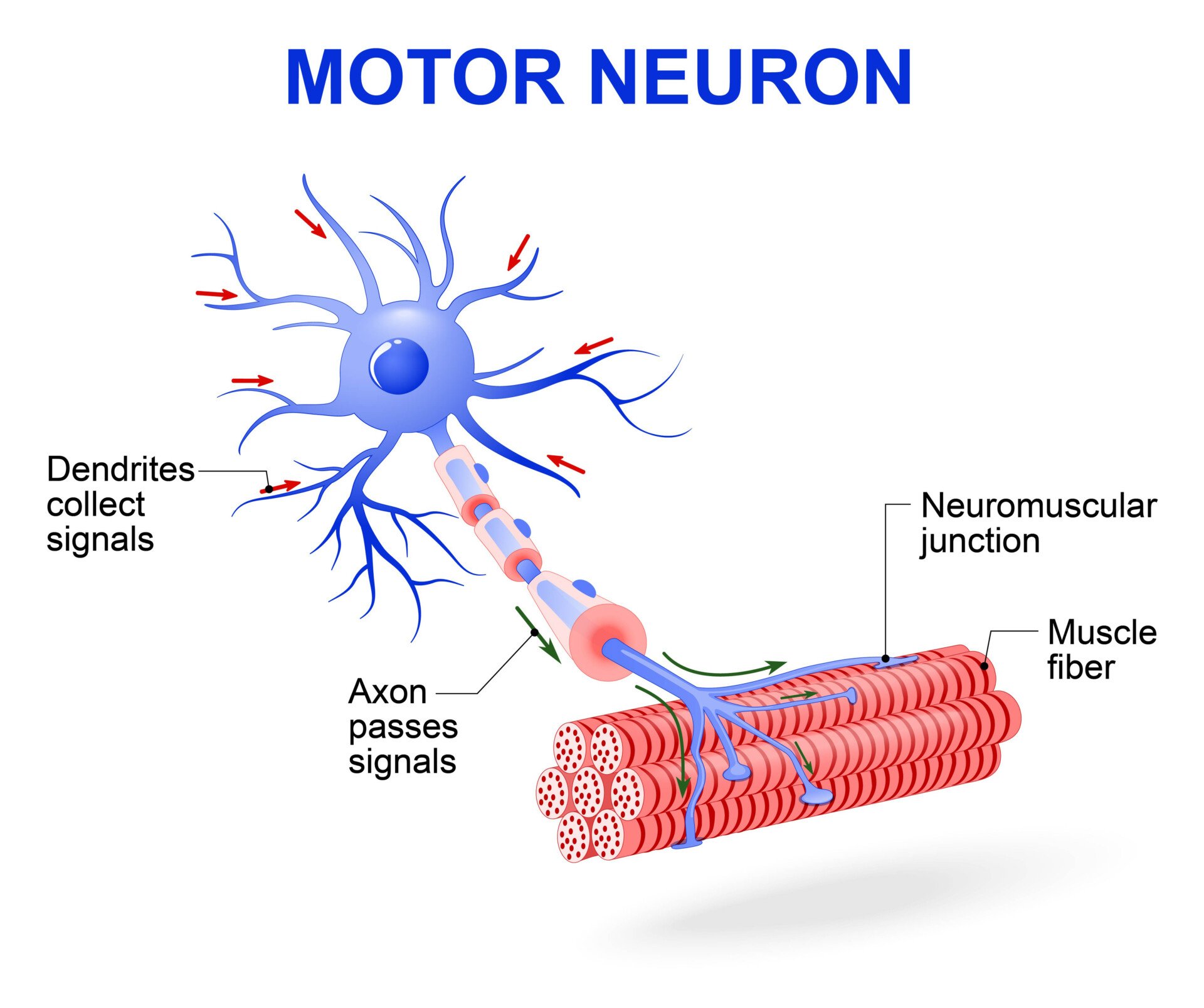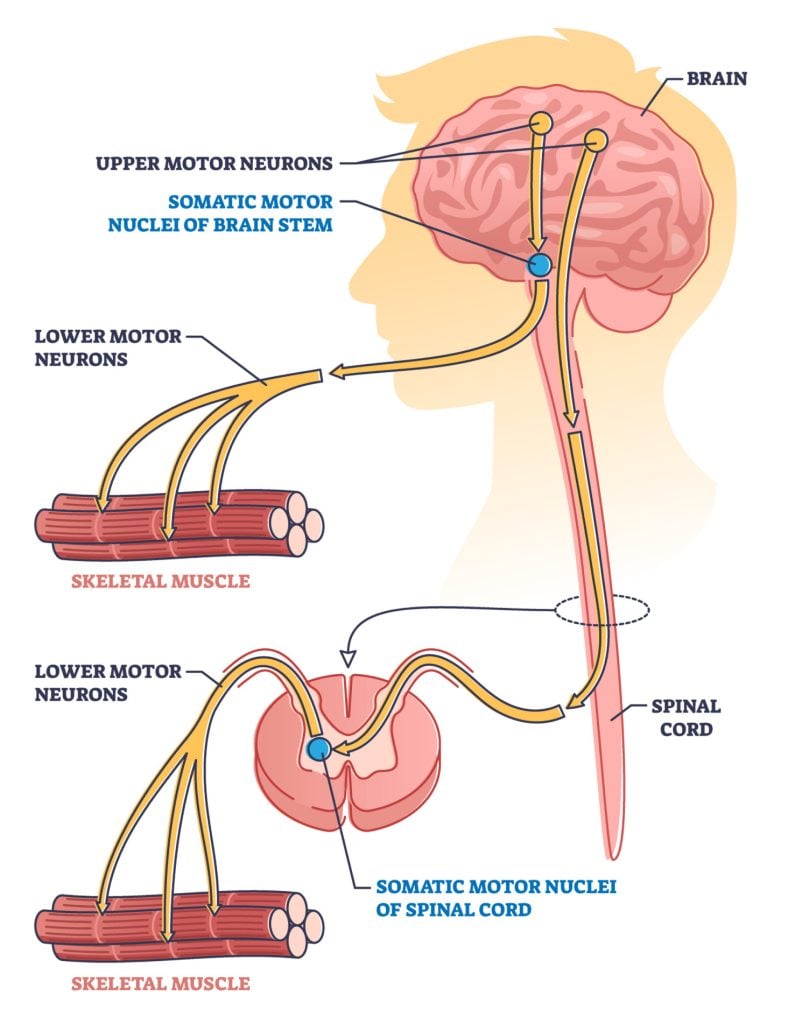On This Page:
Motor neurons (also referred to as efferent neurons) are the nerve cells responsible for carrying signals away from the central nervous system towards muscles to cause movement. They release neurotransmitters to trigger responses leading to muscle movement.
These movements can be voluntary, such as reaching out to pick up an item, or involuntary, such as causing a hand to move away from a hot surface.
Motor neurons integrate signals from the brain to the muscles, glands, and organs that intend to carry out the required motor function. Motor neurons allow us to move, talk, eat, swallow, and breathe; therefore, without these cells, we would be unable to complete many basic life functions.
There are two types of motor neurons:
- Lower motor neurons – these are neurons that travel from the spinal cord to the body’s muscles.
- Upper motor neurons – these are neurons that travel between the brain and the spinal cord.
Structure
Motor neurons are known as multipolar neurons in terms of their structure. This means that they have a single axon and multiple dendrites. Motor neurons are the most common structure for neurons.

The structure of a motor neuron can be categorized into three components: the soma, the axon, and the dendrites.
- The soma is the cell body where the nucleus lies, which controls the cells and is also where proteins are produced to maintain the functioning of the neuron.
- The dendrites are the branch-like structures found at the ends of the neuron. The dendrites use these structures to send and receive information from other neurons.
- The axon is the long extension structure stemming from the soma. The axon works to transmit the information it receives down its body to the dendrites at the end of the neuron.
Motor neurons are located in the central nervous system (CNS), specifically in the motor cortex, brainstem, and spinal cord. Motor neurons are also known as efferent neurons, meaning they carry information from the CNS to muscles, and other peripheral systems such as organs and glands.
This contrasts with afferent neurons, or sensory neurons, which carry information from sensory organs and tissues back to the CNS.
There are approximately 500,000 motor neurons carrying information from the CNS to peripheral organs, muscles, and glands. Efferent fibers are the axons of the motor neurons responsible for this.
Whilst the soma of the motor neurons is located in the CNS, the fibers, or axons, project out of the CNS to where it intends to cause motor action.
The efferent fibers are the longest in the body, with one of the longest axons stretching from the base of the spinal cord to the toes.
Types of Motor Neurons
Motor neurons can be divided into two types of neurons, depending on their function: upper motor neurons and lower motor neurons. These neurons form a variety of controlled and complex circuits throughout the body, controlling both voluntary and involuntary movements.
Upper Motor Neurons
The upper motor neurons are located in either the brain’s motor cortex or the brainstem. The motor neurons initiate voluntary movement throughout the body by connecting the cerebral cortex to the brain stem and spinal cord.
There are a few tracts, or pathways that upper motor neurons can travel, which serve different functions: pyramid, extrapyramidal, rubrospinal, tectospinal, and reticulospinal tracts.
- In the pyramid tract, the upper motor neurons will be responsible for controlling conscious movement. The pyramid tract starts in the motor strip of the frontal lobe, and the nerve impulses travel from here to the spinal cord.
- The extrapyramidal tract is any pathway that is outside of the pyramid tract. These will usually involve subconscious motor functions such as posture and balance.
- The rubrospinal tract is an extrapyramidal tract involved in involuntary movements to maintain and improve the body’s balance.
- The tectospinal tract is an extrapyramidal tract responsible for the movements of the muscles within the neck.
- Finally, the reticulospinal tract is important in controlling autonomous actions in the body.
The upper motor neurons travel down one of the aforementioned tracts, where they will then synapse or form connections with neurons located within the spinal cord, called lower motor neurons.
Lower Motor Neurons
Lower motor neurons, located in the spinal cord, are responsible for communicating signals to the skeletal muscles, organs, and glands.
They receive information from the upper motor neurons, either directly or via interneurons, and stimulate their activity, extending their fibers to their appropriate destinations.
There are a few subtypes of lower motor neurons: somatic, special visceral efferent, and general visceral motor neurons.
Somatic motor neurons originate in the central nervous system, specifically the brainstem, and project their axons to skeletal muscles. Somatic motor neurons can be further divided into alpha, beta, and gamma motor neurons.
- Alpha motor neurons are relatively large motor neurons that innervate skeletal muscle and cause the muscle contractions that generate movement. Specifically, they innervate extrafusal muscle fibers, which are standard muscle fibers.
- Beta motor neurons are not as well categorized as alpha motor neurons, but are understood to also innervate extrafusal muscle fibers, as well as intrafusal fibers, which serve as specialized sensory organs and are innervated by both motor and sensory fibers.
- Gamma motor neurons respond to stretch receptors of the skeletal muscle, also known as muscle spindles. Although known as a motor neuron, gamma motor neurons do not cause any motor function directly. Instead, they are thought to be activated alongside the alphas to fine-tune the muscle contraction.
Special visceral efferent neurons (also known as branchial motor neurons) are responsible for innervate the muscles of the head and neck.
These are located in the brain stem and together with the sensory neurons, form the nuclei of some of the cranial nerves (trigeminal, facial, glossopharyngeal, vagus, and accessory nerves).
General visceral motor neurons contribute to both the sympathetic and parasympathetic functions of the autonomic nervous system (ANS).
The functions of the ANS are not consciously controlled and rely on the visceral motor neurons to stimulate all peripheral functions, such as innervating the heart, smooth muscle, and glands. The only area they do not stimulate is the skeletal muscles.
Neurotransmitters
Acetylcholine
Acetylcholine (ACh) is a neurotransmitter (chemical messenger) found in the central nervous system and is used by lower motor neurons. ACh’s main function is focused on motor movements and is therefore associated with motor neurons.
ACh is an excitatory neurotransmitter at the neuromuscular junction in skeletal muscle, causing the muscle to contract. ACh is stored in the vesicles at the ends of the motor neurons, which produce the chemical.
When a nerve impulse arrives at the terminals of a motor neuron, ACh is released into the neuromuscular junction.
The neuromuscular junction is a specialized chemical synapse between a motor neuron and a muscle fiber which is responsible for converting electrical impulses generated by the neuron into electrical activity in the muscle.
Synaptic transmission at this junction begins when an action potential travels down the motor neuron and reaches the presynaptic terminal of that neuron.
This activates voltage-gated calcium channels, allowing calcium ions to enter the neuron. Calcium ions then trigger the release of ACh into the neuromuscular junction.
Once released into the neuromuscular junction, ACh then attaches to receptor molecules in the postsynaptic membrane of the muscle fiber.
Binding to the receptors on the muscle fiber, the ACh causes the muscles to contract.
Glutamate
Glutamate is another neurotransmitter utilized by motor neurons. Glutamate is a neurotransmitter used by the upper motor neurons, in contrast with ACh being used by the lower motor neurons.
Glutamate is, therefore, mostly prevalent within the central nervous system, known as the most abundant neurotransmitter.
This chemical is excitatory, used in every major excitatory function in the brain, and accounts for over 90% of synaptic connections in the brain.
Although not specific to motor neuron function, it is still an important neurotransmitter to begin the process of muscular movements.
Damage to Motor Neurons
Damage to the upper and lower motor neurons can result in different side effects. Damage to the upper motor neurons is also called pyramidal insufficiency and can come as a result of a variety of disorders such as multiple sclerosis (MS), stroke, cerebral palsy, and spinal or brain injury.
This damage to the upper motor neurons stops electrical signals from reaching the muscles. When muscles do not move for an extended period, they can become weakened, stiff, and make it harder to walk or coordinate movements.
Long-lasting effects of this damage could result in upper motor neuron disease with symptoms including muscle weakness, poor posture, poor motor control, and exaggerated reflex responses.
If the lower motor neurons are damaged, this could be as a result of infections such as Lyme disease, trauma to the peripheral nerves, or viruses that can attack the cells. Some of the symptoms of damage to lower motor neurons include muscle paralysis and muscle weakness.
Motor neuron diseases come because of damage to the motor neurons. These diseases tend to affect muscle control and can also affect speaking, eating, breathing, and walking as a result.
There are many forms of motor neuron disease, a common one being amyotrophic lateral sclerosis (ALS). This disease affects both the upper and lower motor neurons with symptoms present as weakness and stiff movements in the legs, as well as limp paralysis and muscles being unresponsive to stimuli in the arms.

ALS is a neurodegenerative disease, and eventually, symptoms will worsen, and patients usually die within four years of having the disease. Although there is currently no known cure for motor neuron diseases, there are treatments to help reduce the impact of some of the symptoms.
These can include having occupational therapists, physiotherapists to help with exercises to reduce stiffness, and speech and language therapists.
References
Liden, D. (n.d.). What is a Motor Neuron? (with pictures). Info Bloom. Retrieved June 16, 2021, from https://www.infobloom.com/what-is-a-motor-neuron.htm
McLaughlin, K. (2020, May 16). Motor Neuron. Biology Dictionary. https://biologydictionary.net/motor-neuron/
Moini, J. & Piran, P. (2020) Histophysiology. Functional and Clinical Neuroanatomy. Academic Press. https://doi.org/10.1016/B978-0-12-817424-1.00001-X
Physiopedia. (n.d.). Motor Neurone. Retrieved June 16, 2021, from https://www.physio-pedia.com/Motor_Neurone
Slater, C. R. (2009). Neuromuscular junction (NMJ): mammalian development. DEVELOPMENTAL NEUROBIOLOGY, 529.
Zayia, L. C., & Tadi, P. (2020). Neuroanatomy, Motor Neuron. StatPearls [Internet].
Further Reading



